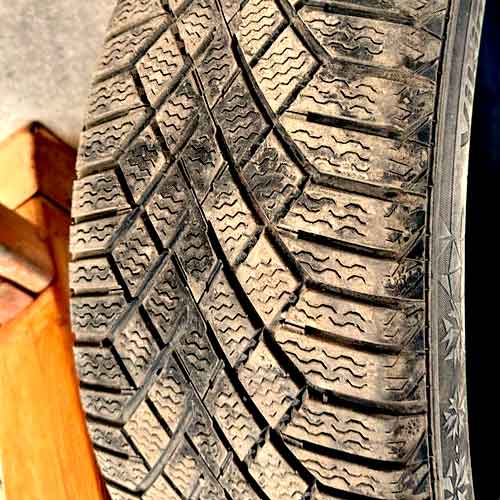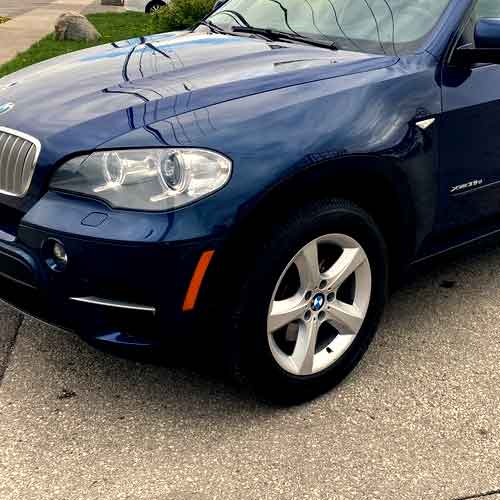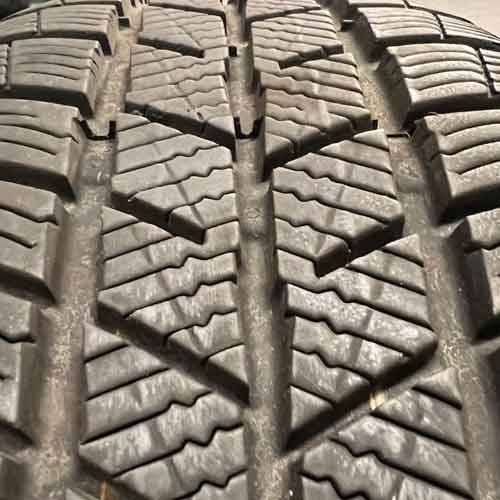With its strong reputation for icy and snowy roads, the Continental VikingContact 7 is one of best German manufacturer’s winter offerings. But are there better options? Well, you’re about to find out.

The Continental VikingContact 7 excels in winter conditions with superior ice and snow traction. It has good hydroplaning resistance and wet grip, moderate tread noise, and commendable dry road handling. While its tread durability is average, its design promotes longevity and enhanced fuel efficiency.
For Your Info: The Continental VikingContact 7 comes in 14 to 22 inches.
- These sizes have speed ratings of H and T.
- Load ratings comes in SL and XL (mostly).
- Tread depth is 10/32″ on all sizes.
- And weight ranges from 14 lbs and goes up to 35 lbs, (on the heaviest size).
Tread Structure
The Continental VikingContact 7 comes with a very packed up tread design, having a directional pattern.

So, it’s tread comes in two prominent sections.
One, it’s elongated shoulder lugs, and two, its central area consisting of squared off blocks.
Both of them together make very strong outer circumferential grooves, which are of course interconnected with others in the middle, allowing for superb resistance to hydroplaning (with efficient water evacuation capability).
The central lugs are intricately designed with wave-like sipes and chamfered sides, and have sharp edges.
Moreover, they are positioned atop secondary rubber layers, which act as reinforcing bases, so the spaces between these lugs function as in-groove notches.
Transitioning to the tread’s edges, the shoulder blocks are elongated and come in connected pairs.
These blocks, besides having sharper contours, feature a pronounced and dense siping pattern.
Moreover, they’re interspersed with broad lateral gaps, enhancing the tread’s self-cleaning capabilities.
Enhanced Winter Performance Overview
The efficiency of a tire in winter is largely dictated by its competence over two predominant terrains: ice and snow.
Let’s delve into each.
Ice Traction
Ice traction measures a tire’s proficiency in gripping and navigating icy surfaces.
Given the inherent slickness of ice and its minimal friction, achieving dependable traction is predominantly a function of the tire’s specialized rubber composition and intricate tread designs.
The key to exemplary performance on ice lies in a tire packed with numerous biting edges, while simultaneously maintaining flexibility even under severe cold conditions.
And this is exactly what the Continental VikingContact 7 provides you here.
The tire with specialized Nordic compound keeps its lugs thermally adaptive, while with varying interlocking siping throughout its tread combined with V-shaped in-groove notches (made by central squared blocks), you get ample bite.
Moreover, the tire also features a lighter overall structure as well, with a very composed tread, having foundational supports or as Continental likes to call them “solid linkage”.
These together basically keep the momentum force low, allowing for faster handling and steering responsiveness, and minimum slippage.
Though if you’re looking for the best tire here, you should check out the Bridgestone Blizzak WS90 (review), this tire is pretty great, offering 5 feet shorter ice braking distance (on average), compared to VikingContact (which comes in at second place in my tests among all premium winter tires).
Snow Traction
When it comes to snow-covered roads, it’s all about a tire’s ability to effectively penetrate, grip, and subsequently release extra snow (accumulating in the tread).
Put simply, tires must foster an efficient snow-to-snow connection here to provide decent overall performance.
But why this contact is important?
The answer lies in the unique structures of snowflakes, which enable them to interlock with each other, facilitating a stronger bond with one another, compared to rubber.
Now, here the Continental VikingContact 7 offers pretty great results, where it’s inter-connecting grooves everywhere offer ample and efficient snow to snow contact, enhancing grip.
To give you an idea, its overall snow braking/handling is just as great as the best winter tire here.
For Your Info: Out of all it’s direct competitors, the Michelin X-Ice Snow (review) offers the best overall snow performance.
Wet Traction
Wet traction hinges on both the tire’s tread configuration and its rubber formulation. These elements influence the two pivotal facets of wet performance: wet grip and hydroplaning resistance.
Now the Continental ranks on top in all these aspects. In fact, I added this tire as the top wet performer, in my list of best studless winter tires.
Wet Grip
Wet grip is also determined by the volume of rubber interacting with the road, but the thing is water comes in the way, if it’s not cleared out in time.
So overall it depends on how well tire takes out water.
Enter grooves and sipes.
While grooves shoulder the responsibility of discharging most of the water, ensuring hydroplaning resistance (which we’ll explore in the next sub-topic), sipes tackle residual water at the microscopic level.
These sipes, embedded with air, exert it out, creating a vacuum effect. This mechanism draws in and removes water particles beneath them, facilitating clearer surface contact for the tire rubber.
Now, the Continental VikingContact 7 is one of the best tire in this domain, as it incorporates a very aggressive siping pattern that combines dual wave-like patterns (varying in thickness).
Moreover, as these sipes have multiple orientation/angles to them, they effectively grip in all directions.
Though most of its traction is coming from its hydroplaning resistance. Let me explain it in a separate section.
Mitigating Hydroplaning
Hydroplaning happens when water intervenes between the tire and the road. This is because water is incompressible and it fails to escape, it can potentially lead to total traction loss, or the tire to hydroplane or float.
To combat this, tires are designed with grooves, specifically tailored to channel water away and prevent this hazardous event.
Now the Continental VikingContact 7 excels, here, as throws out water very efficiently.
This is all thanks to it’s directional pattern, having voids running in all directions, thanks to it’s squared off lugs in the middle.
Moreover, the tire also has the advantage in terms of its well engineered contact patch. It’s tread is basically designed in a way, so it could put more pressure on the water, so it could leave out with greater force/push.
But how is helping its overall wet performance?
Well, this is because most of the water already passes out through grooves, and sipes, which come in later have less work to do, to begin with.
Comfort Parameters
The degree of comfort a tire offers stems from its ability to minimize road noise and adeptly absorb vibrations. And here, factors such as tire composition, tread design, and sidewall structure play pivotal roles in ensuring a serene ride experience.
Let’s break down these elements.
Tread-Induced Noise
Now when it comes to tread noise, the Continental VikingContact 7 offers just an okay performance here, where it’s open shoulders allow air particles to easily move in and hit around causing noise.
Basically noise is the main cause of noise, where the impact of the air particles striking with the walls, produces primary noise, which then leads to in-groove resonance.
Now although the Continental is a little louder compared to other winter options, its still not that bad.
I mean, its noise is could have gotten worse, if it wasn’t for its special Nordic compound and ContiSilent technology (as Continental likes to call them). It basically keeps the in-groove resonance limited, relatively.
Shock Absorption
When it comes to overall ride experience, the internal and outer construction of the tire has a lot to offer.
And the Continental VikingContact 7, although gets to be louder, it still features better performance in this, other half of overall comfort.
The tire offers a mix of needed softness and rigidity here, allowing for efficient shock absorption, with a control as well.
Dry Road Performance
Overall dry performance is two parts, grip and handling. The grip is fundamentally about the rubber’s interaction with the road and is divided into two segments: directional and lateral adherence.
Let’s start with directional.
Directional Dry Grip
This type of grip pertains to the tire’s linear adhesion, and it’s efficiency predominantly lies in the tire’s central tread engagement with the road surface.
Moreover, as the central tread area bears maximum weight when the tire rolls linearly, it’s intuitive that its traction directly influences braking effectiveness.
While most of the premium winter tires feature continuous central ribs for persistent road contact, the Continental VikingContact 7 lacks with that. Though the tire still features a more enclosed pattern, extending even to the peripheral lugs.
And it’s this uniformity of its tread that still allows it to have above average directional grip, as seen by its appreciable braking distances (on tests).
I mean the tire only lacks by a mere 2 feet in overall braking tests (on average), compared to Blizzak WS90.
Though it still takes the lead in overall handling. Let me explain why in the separate section.
Dry Handling Proficiency
When it comes to dry handling, you should know that it’s a synergy between a tire’s overall traction and its feedback during steering.
Now we have already seen the directional traction, whereas lateral traction, which tells you about tire’s side-to-side grip, is greatly influenced by the tire’s shoulder components.
This is because as the maneuvers, its shoulder or sidewall regions increasingly engage with the road. The precision and extent of this interaction play a crucial role in determining a tire’s handling capabilities.
Having said that it can be explained why the Continental VikingContact 7 offers best dry handling times among all premium winter tires out there, even outperforming Blizzak WS90 (which comes in at the 2nd place).
This is mainly because of the tire’s stiffer internal nylon cap ply, which keeps its shoulder firm as its cornering, adding to its better overall steering responsiveness.
Tread Durability
Tread durability primarily hinges on two intertwined factors: rolling resistance and tread depth. And interestingly, there are two things to note here.
One, the tread depth has a direct relationship with tread lifespan, meaning, a tire with more tread depth is likely to last longer before hitting the standard minimum tread depth of 2/32″ (as required in places like the U.S.).
And two, it has an inverse relation with rolling resistance. Meaning deeper treads tend to flex more, resulting in heat generation and amplified rolling resistance.
And that’s where the Continental VikingContact 7 comes in, with it’s good enough tread depth, with a mixture of reinforced foundations.
So get a good average tread depth of 10/32″, where lugs aren’t prone to flexing, and you get decent overall mileage.
Moreover, its rubber is also not too soft, (which of course prevents it from negatively impacting wear).
And yes, like already explained, the tire has the edge of even distribution of weight among its lugs, or as Continental likes to call it ContiForce, so its overall tread longevity remains above average compared to other tires in the category.
Fuel Efficiency
A tire’s contribution to fuel efficiency is intricately tied to its mass and grip, both of which impact rolling resistance.
So what I mean by that?
Well, notably, a bulkier tire with pronounced tread gaps often undergoes enhanced lug flexing during maneuvers like turns, stops, or accelerations. This additional flexing, rather than aiding in propelling the vehicle forward, expends energy in restoring the lug’s shape or as heat, thereby slightly diminishing fuel efficiency.
With this in mind, the Continental VikingContact, being lighter, performs better in this regard. Its reduced weight relieves pressure on its lugs, resulting in lower rolling resistance.
Further, the tire’s streamlined and uniform tread pattern facilitates smoother rolling compared to most of it’s competitors.
Though being winter tires, you can’t expect too much out of them, of course.
To Sum Up
The Continental VikingContact 7 is a versatile winter tire that exhibits great performance across a range of conditions.
On icy terrains, its Nordic compound ensures adaptability, and the tire’s intricate tread design provides significant traction.
For snow-covered roads, its design promotes efficient snow-to-snow contact for enhanced grip.
Wet conditions see the tire delivering satisfactory performance due to aggressive siping patterns and effective hydroplaning resistance.
And on dry, it offers you with a reliable grip and superior handling.
Lastly, its lightweight construction and efficient design yield good enough fuel efficiency, as well.

